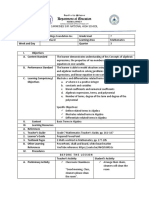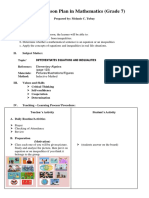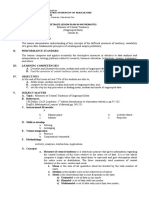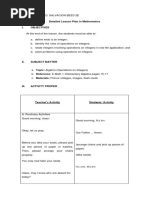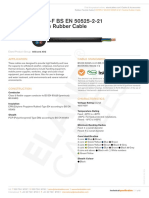Lesson Plan in Math Integers
Uploaded by
Jonard PalahangLesson Plan in Math Integers
Uploaded by
Jonard PalahangDetailed Lesson Plan in Mathematics
I. OBJECTIVES
At the end of the lesson, the students must be able to:
a. define what is an integer;
b. identify the rules of operations on integers;
c. relate integers involving operations on integers in real life application; and
d. solve problems using operations on integers.
II. SUBJECT MATTER
a. Topic: Algebra (Operations on Integers)
b. Reference: E-Math 1: Elementary Algebra pages 15-17
c. Materials: Picture collages, images, flash cards
III. ACTIVITY PROPER
Teacher’s Activity Students’ Activity
A. Routinary Activities
Good morning, class!
Good morning, Ma’am.
Okay, let us pray.
Our Father ... Amen.
Before you take your seats, please pick
(arrange chairs and pick up pieces of
up any pieces of paper or trashes.
paper)
Then, please arrange your chairs
properly. (take seats)
You may now take your seats.
No one, Ma’am
Class, may I know who are absent for
today?
Very good! It is nice to know that you
(clap hands)
really love my subject, Mathematics.
So, let’s give everybody a round of (raise hands)
applause.
Now, we will have another interesting
topic for today. But, before that, let’s
play a game. Raise your hand if you
want games.
B. Preparation
Yes, Ma’am.
1. Motivation
Let’s play 4-Pics-1-Word. Are you
familiar with that? (choosing of representatives)
But, we will have this game a twist.
Instead of giving letters as hints, you
will act the word being guessed. I will
divide the class into groups. The left
side is Group 1 and the right side is
Group 2. Then, both groups will choose
a representative to act the given
picture. The rest members of the group
will guess the word. The pictures to be
guessed have numbers and the (starting guessing)
representative will pick by lot. I will only
give two minutes each group. The more
words to guess, the more you win. So,
choose your representatives.
Now, let’s begin with Group 1. (holds (starting guessing)
the picture being chosen by the
representative)
(clapping hands)
(after two minutes) Time’s up. Good
job, Group 1. Next is Group 2.
Two minutes passed. Thanks, Group 1.
The winner is __________. A round of
applause to everyone for a wonderful (read the words)
game.
Class, what are the words being
guessed?
C. Presentation
The words are related to operations
So, what have you observed on those
because of the add, divide, subtract
words in our game.
and multiply.
Yes, those are operations. But, it will
have something to do with our new
topic for this morning.
Today, you will learn how to compute
numbers with signs, the positive and
negative in operations. And we will
encounter integers.
We will be having an activity. I will
divide the class into four groups. This
will be row groups. Each group will be
given flash cards with number
problems and corresponding letters.
(working together as groups)
Then, you will solve it as a group. After
you solve, the answers of the flash
cards must be arranged into lowest to
highest value so that you can get the
hidden word. But, how you will solve
the number problem? I will give you an
Addition, Subtraction, Multiplication,
“Ace” card. This is a card containing
Division.
the rules on solving. The first group to
finish and accomplish the task will be
the winner and there will be a
corresponding prize for it.
D. Comparison and Abstraction
Positive and Negative sign
Among the cards, what operations are
used?
Very good! These operations will help It is below zero.
to solve the numbers with signs.
These signs are?
It is above zero.
If a number has a negative sign, what
There are rules in solving operations on
does it imply?
integers.
That’s right. If a number has no sign,
that is a positive number. What does it
mean?
How did you get the answers on doing
the activity?
E. Generalization
These are called integers. It is a
positive and negative whole number or
it’s exact opposites.
So, these integers can be applied on
operations. There are rules on getting
the answers.
The answer is a positive integer.
First is in addition. What would be the
result if a positive integer is being
added to a positive integer.
The answer is a negative integer.
If a negative integer is added with a
The answer will depend on the bigger
negative integer?
integer.
That’s right! The sign will stay as it is.
What would be the answer if a positive
integer is being added to a negative
integer?
In subtraction, this rule is the same with The answer is still positive.
addition. In multiplication and division,
The answer is a negative integer.
they also have the same rules. If both
positive is being multiplied and divided,
the answer is?
Yes, Ma’am.
If the factors have different signs?
If the dividend and divisor have
different signs?
(posts some examples)
Then, this integer won’t be nothing if
this is not applicable to reality. Have
you notice about thermometers? There
is a negative integer because there are
temperatures which are below 0°. It is
the decrease of temperature. Then,
when you deposit a money in your
bank account. Your savings will rise.
There will be positive money on a bank.
Integers really help in keeping the
world on working.
F. Application
In your seats, make at least 5
examples which can be applicable in
real life situations. Then, exchange with
your seatmate. Let your seatmate
answer it.
I will give you 10 minutes to do your
task.
(after 10 minutes)
Give back the paper then let the maker
of the examples check the answers of
his/her seatmate. Then, after checking,
pass the papers to me.
G. Evaluation
Direction: In a 1/2 sheet of paper,
answer the following:
1. -8 + 20 =
2. 90 - 105 =
3. 50/-5 =
4. 6*10 =
5. -7*-300 =
6. -100/10 =
7. -5 + -2 =
8. -2 - 4 =
9. 0*-2 =
10. 34*-12 =
H. Assignment
Direction: Fill in the blanks.
1. ___ * - 40 = 80
2. 6 - ___ = -28
3. 45 / -9 = ___
4. -9 * -367 = ___
5. -2 + ___ = -78
You might also like
- 01 Introduction To Algebra - Lesson Plan - Jelo Clavel (Student Teacher)100% (1)01 Introduction To Algebra - Lesson Plan - Jelo Clavel (Student Teacher)9 pages
- A Detailed Lesson Plan in Mathematics (The Set of Integers)No ratings yetA Detailed Lesson Plan in Mathematics (The Set of Integers)11 pages
- 8thLP Graphs A Linear Equation Given Two Points and Intercepts 7pgs100% (1)8thLP Graphs A Linear Equation Given Two Points and Intercepts 7pgs7 pages
- FSA Guidance Document - As Published 08.03.2019 1.0No ratings yetFSA Guidance Document - As Published 08.03.2019 1.031 pages
- 670 Series Version 2.2 IEC: Installation ManualNo ratings yet670 Series Version 2.2 IEC: Installation Manual100 pages
- Detailed Lesson Plan in Mathematics 7 I. Objectives100% (1)Detailed Lesson Plan in Mathematics 7 I. Objectives5 pages
- Detailed Lesson Plan (Operation On Integers) LadyNo ratings yetDetailed Lesson Plan (Operation On Integers) Lady9 pages
- Detailed Lesson Plan in Mathematics (Multiplication and Division of Integers)100% (1)Detailed Lesson Plan in Mathematics (Multiplication and Division of Integers)8 pages
- Detailed Lesson Plan On Operations On Integers100% (2)Detailed Lesson Plan On Operations On Integers7 pages
- Detailed Lesson Plan in Mathematics (Grade 7) : Elementary AlgebraNo ratings yetDetailed Lesson Plan in Mathematics (Grade 7) : Elementary Algebra4 pages
- Division of Integers Detailed Lesson Plan in MathematicsNo ratings yetDivision of Integers Detailed Lesson Plan in Mathematics11 pages
- WEEK 8 Represents Integers On The Number Line M6NS-IIh - 153100% (1)WEEK 8 Represents Integers On The Number Line M6NS-IIh - 15336 pages
- Code: M7Al-Iic-3: Lesson Plan in Mathematics 7 September 17, 2019 8:40am - 9:40am I-Learning Objectives100% (1)Code: M7Al-Iic-3: Lesson Plan in Mathematics 7 September 17, 2019 8:40am - 9:40am I-Learning Objectives3 pages
- Detailed Lesson Pan (Probability of Simple Events)No ratings yetDetailed Lesson Pan (Probability of Simple Events)8 pages
- Math7 - q1 - CLAS3 - Absolute-Value-of-a-Number-and-Operations-on-Integers-v3 - RHEA ANN NAVILLA-pages-4-5No ratings yetMath7 - q1 - CLAS3 - Absolute-Value-of-a-Number-and-Operations-on-Integers-v3 - RHEA ANN NAVILLA-pages-4-52 pages
- Detailed Lesson Plan in Mathematics 9 FinalNo ratings yetDetailed Lesson Plan in Mathematics 9 Final8 pages
- Detailed Lesson Plan School Quezon National High School Grade Level 7 Teacher Sherwin S. Castillo Learning Area Mathematics Time & Dates QuarterNo ratings yetDetailed Lesson Plan School Quezon National High School Grade Level 7 Teacher Sherwin S. Castillo Learning Area Mathematics Time & Dates Quarter3 pages
- Grade 8 LP Measures of Central Tendency Ungrouped DataNo ratings yetGrade 8 LP Measures of Central Tendency Ungrouped Data8 pages
- Detailed Lesson Plan School Quezon National High School Grade Level 7 Teacher Sherwin S. Castillo Learning Area Mathematics Time & Dates QuarterNo ratings yetDetailed Lesson Plan School Quezon National High School Grade Level 7 Teacher Sherwin S. Castillo Learning Area Mathematics Time & Dates Quarter9 pages
- Lesson Plan in Mathematics Grade 9jenchen NewNo ratings yetLesson Plan in Mathematics Grade 9jenchen New6 pages
- Tracer Study BSED - Mathematics Graduates Information Sheet: General ProfileNo ratings yetTracer Study BSED - Mathematics Graduates Information Sheet: General Profile7 pages
- WEEK 9.34 Lesson Plan Word Problems Linear InequalitiesNo ratings yetWEEK 9.34 Lesson Plan Word Problems Linear Inequalities8 pages
- DAILY LESSON LOG OF M7NS-if-1 (Week Six - Day Four)No ratings yetDAILY LESSON LOG OF M7NS-if-1 (Week Six - Day Four)4 pages
- COT 1-DLP in MATH 7 - The Absolute Value of A Number100% (1)COT 1-DLP in MATH 7 - The Absolute Value of A Number3 pages
- Name: Ella Marie D. Salvacion Beed 2E Detailed Lesson Plan in Mathematics I. ObjectivesNo ratings yetName: Ella Marie D. Salvacion Beed 2E Detailed Lesson Plan in Mathematics I. Objectives7 pages
- Detailed Lesson Plan in Mathematics 7 - Inductive Method100% (1)Detailed Lesson Plan in Mathematics 7 - Inductive Method5 pages
- Homework Helpers: Basic Math and Pre-Algebra, Revised EditionFrom EverandHomework Helpers: Basic Math and Pre-Algebra, Revised EditionNo ratings yet
- Signed Off - Media and Information Literacy1 - q1 - m2 - Media Department - v3100% (1)Signed Off - Media and Information Literacy1 - q1 - m2 - Media Department - v347 pages
- Question 1: Suppose You Are Given The Following Requirements For A SimpleNo ratings yetQuestion 1: Suppose You Are Given The Following Requirements For A Simple13 pages
- Smart Bridge - Automatic Height Increase During FloodingNo ratings yetSmart Bridge - Automatic Height Increase During Flooding12 pages
- Rheingold ISTA Common Questions - Errors and FixesNo ratings yetRheingold ISTA Common Questions - Errors and Fixes22 pages
- h07rn F Bs en 50525 2 21 Flexible Rubber CableNo ratings yeth07rn F Bs en 50525 2 21 Flexible Rubber Cable6 pages
- Dryer Design - Assignment: Progresive Oven Compartment OvenNo ratings yetDryer Design - Assignment: Progresive Oven Compartment Oven8 pages
- Wiggins Vr300 Non Pressurising Ultra Fast Fil Diesel Refuelling SystemsNo ratings yetWiggins Vr300 Non Pressurising Ultra Fast Fil Diesel Refuelling Systems3 pages
- Advanced Systemcare Pro 12.6.0.368 Crack With License KeyNo ratings yetAdvanced Systemcare Pro 12.6.0.368 Crack With License Key2 pages
- 812732: Godrej Prakriti-Tower R - Structural Concrete - Pre ChecksNo ratings yet812732: Godrej Prakriti-Tower R - Structural Concrete - Pre Checks2 pages
- Parameters For Selection of Pumps For Different Applications67% (3)Parameters For Selection of Pumps For Different Applications10 pages
- Hydrostatic Motor & Brake (2-Speed Option) (R921810294) - S300No ratings yetHydrostatic Motor & Brake (2-Speed Option) (R921810294) - S3004 pages
- 01 Introduction To Algebra - Lesson Plan - Jelo Clavel (Student Teacher)01 Introduction To Algebra - Lesson Plan - Jelo Clavel (Student Teacher)
- A Detailed Lesson Plan in Mathematics (The Set of Integers)A Detailed Lesson Plan in Mathematics (The Set of Integers)
- 8thLP Graphs A Linear Equation Given Two Points and Intercepts 7pgs8thLP Graphs A Linear Equation Given Two Points and Intercepts 7pgs
- FSA Guidance Document - As Published 08.03.2019 1.0FSA Guidance Document - As Published 08.03.2019 1.0
- Detailed Lesson Plan in Mathematics 7 I. ObjectivesDetailed Lesson Plan in Mathematics 7 I. Objectives
- Detailed Lesson Plan in Mathematics (Multiplication and Division of Integers)Detailed Lesson Plan in Mathematics (Multiplication and Division of Integers)
- Detailed Lesson Plan in Mathematics (Grade 7) : Elementary AlgebraDetailed Lesson Plan in Mathematics (Grade 7) : Elementary Algebra
- Division of Integers Detailed Lesson Plan in MathematicsDivision of Integers Detailed Lesson Plan in Mathematics
- WEEK 8 Represents Integers On The Number Line M6NS-IIh - 153WEEK 8 Represents Integers On The Number Line M6NS-IIh - 153
- Code: M7Al-Iic-3: Lesson Plan in Mathematics 7 September 17, 2019 8:40am - 9:40am I-Learning ObjectivesCode: M7Al-Iic-3: Lesson Plan in Mathematics 7 September 17, 2019 8:40am - 9:40am I-Learning Objectives
- Detailed Lesson Pan (Probability of Simple Events)Detailed Lesson Pan (Probability of Simple Events)
- Math7 - q1 - CLAS3 - Absolute-Value-of-a-Number-and-Operations-on-Integers-v3 - RHEA ANN NAVILLA-pages-4-5Math7 - q1 - CLAS3 - Absolute-Value-of-a-Number-and-Operations-on-Integers-v3 - RHEA ANN NAVILLA-pages-4-5
- Detailed Lesson Plan School Quezon National High School Grade Level 7 Teacher Sherwin S. Castillo Learning Area Mathematics Time & Dates QuarterDetailed Lesson Plan School Quezon National High School Grade Level 7 Teacher Sherwin S. Castillo Learning Area Mathematics Time & Dates Quarter
- Grade 8 LP Measures of Central Tendency Ungrouped DataGrade 8 LP Measures of Central Tendency Ungrouped Data
- Detailed Lesson Plan School Quezon National High School Grade Level 7 Teacher Sherwin S. Castillo Learning Area Mathematics Time & Dates QuarterDetailed Lesson Plan School Quezon National High School Grade Level 7 Teacher Sherwin S. Castillo Learning Area Mathematics Time & Dates Quarter
- Tracer Study BSED - Mathematics Graduates Information Sheet: General ProfileTracer Study BSED - Mathematics Graduates Information Sheet: General Profile
- WEEK 9.34 Lesson Plan Word Problems Linear InequalitiesWEEK 9.34 Lesson Plan Word Problems Linear Inequalities
- DAILY LESSON LOG OF M7NS-if-1 (Week Six - Day Four)DAILY LESSON LOG OF M7NS-if-1 (Week Six - Day Four)
- COT 1-DLP in MATH 7 - The Absolute Value of A NumberCOT 1-DLP in MATH 7 - The Absolute Value of A Number
- Name: Ella Marie D. Salvacion Beed 2E Detailed Lesson Plan in Mathematics I. ObjectivesName: Ella Marie D. Salvacion Beed 2E Detailed Lesson Plan in Mathematics I. Objectives
- Detailed Lesson Plan in Mathematics 7 - Inductive MethodDetailed Lesson Plan in Mathematics 7 - Inductive Method
- Homework Helpers: Basic Math and Pre-Algebra, Revised EditionFrom EverandHomework Helpers: Basic Math and Pre-Algebra, Revised Edition
- Signed Off - Media and Information Literacy1 - q1 - m2 - Media Department - v3Signed Off - Media and Information Literacy1 - q1 - m2 - Media Department - v3
- Question 1: Suppose You Are Given The Following Requirements For A SimpleQuestion 1: Suppose You Are Given The Following Requirements For A Simple
- Smart Bridge - Automatic Height Increase During FloodingSmart Bridge - Automatic Height Increase During Flooding
- Rheingold ISTA Common Questions - Errors and FixesRheingold ISTA Common Questions - Errors and Fixes
- Dryer Design - Assignment: Progresive Oven Compartment OvenDryer Design - Assignment: Progresive Oven Compartment Oven
- Wiggins Vr300 Non Pressurising Ultra Fast Fil Diesel Refuelling SystemsWiggins Vr300 Non Pressurising Ultra Fast Fil Diesel Refuelling Systems
- Advanced Systemcare Pro 12.6.0.368 Crack With License KeyAdvanced Systemcare Pro 12.6.0.368 Crack With License Key
- 812732: Godrej Prakriti-Tower R - Structural Concrete - Pre Checks812732: Godrej Prakriti-Tower R - Structural Concrete - Pre Checks
- Parameters For Selection of Pumps For Different ApplicationsParameters For Selection of Pumps For Different Applications
- Hydrostatic Motor & Brake (2-Speed Option) (R921810294) - S300Hydrostatic Motor & Brake (2-Speed Option) (R921810294) - S300


